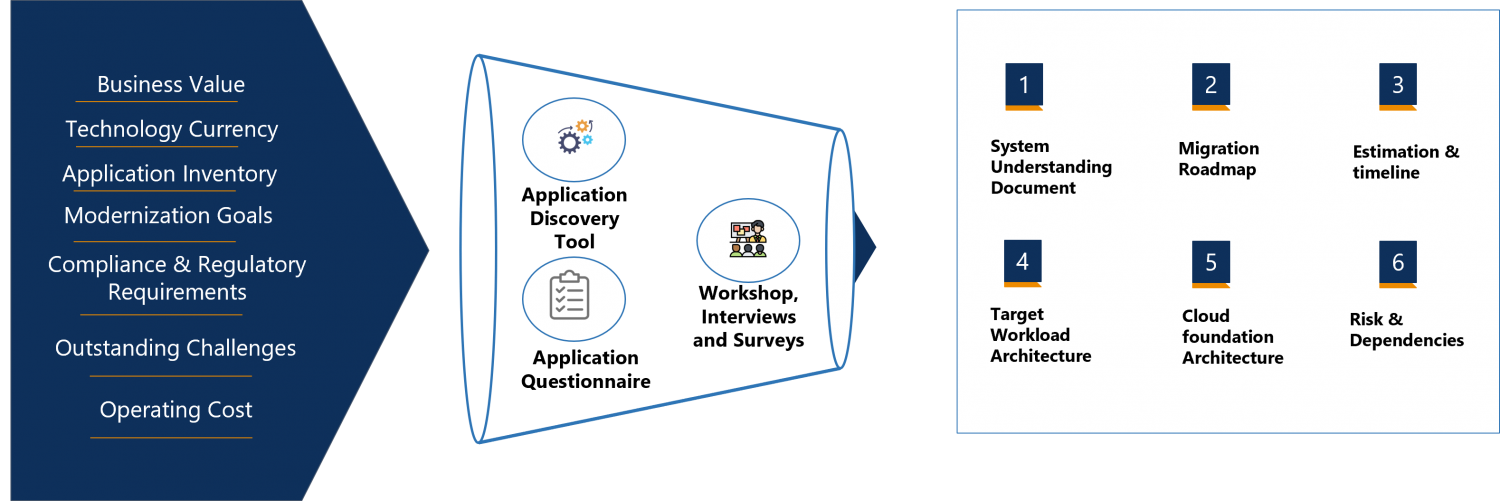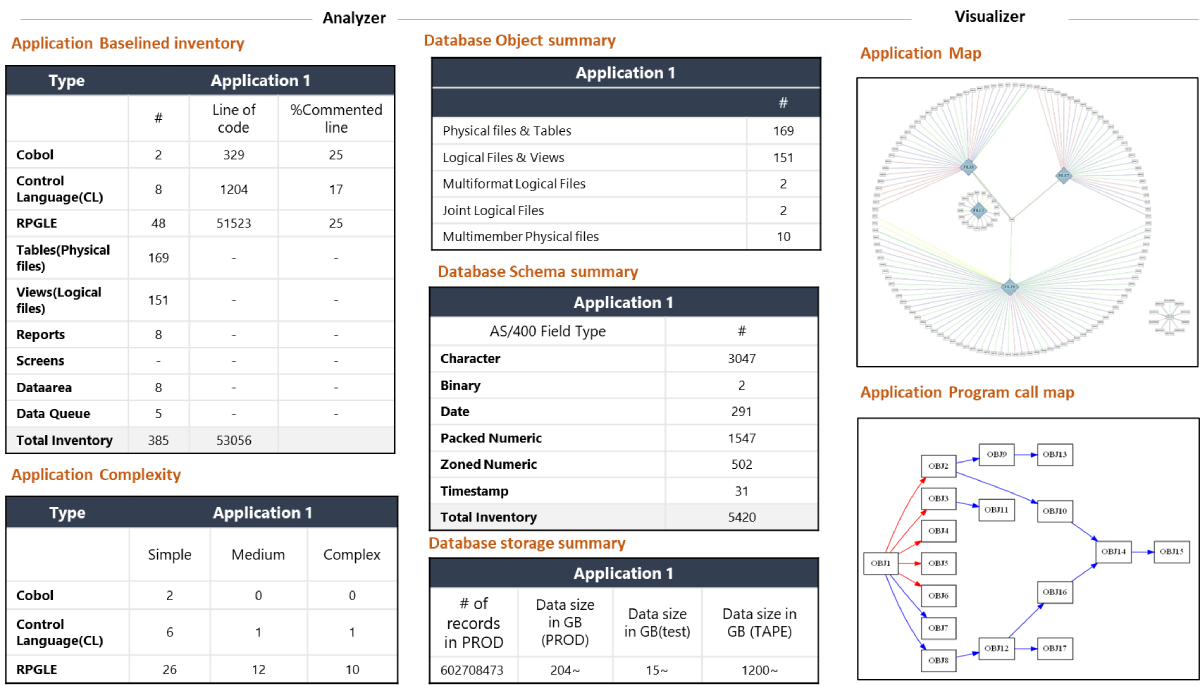LTIMindtree AS400 Discovery Tool | Accelerating AS400 Applications Assessment
Organizations from various sectors are running business-critical workloads on the IBM AS400 platform, which is performant and secure. Current time requires organizations to address ever-changing business demands and to operate at scale with efficiency. This means driving innovation, as well as harnessing the power of cloud computing to create a robust foundation for end-to-end business transformations. Hence the organizations require the right modernization strategy to transform these AS400 workloads.
Decades-old, the AS400 workloads are continuously becoming complex, monolithic, and tightly coupled. With limited documentation, organizations often lack rightful insights into the workloads. To build a successful modernization roadmap, organizations need to deep dive into application inventories to identify the application’s characteristics, dependencies, transaction flows, and interfaces.
LTIMindtree’s AS400 Discovery Framework
LTIMindtree’s AS400 Discovery framework follows the industry’s best practices and guidelines to explore every aspect of the application. The framework considers the following key tenets as input to assess AS400 applications.
Business value – To understand the business criticality of AS400 applications for business growth. The framework captures current and future business requirements, financial impact, operation cost, and business continuity requirements.
Technology currency – To understand the application’s technology currency, the framework captures the technology landscape, age, availability requirements, transaction volumes, third-party tools, source availability, and CPU utilization.
Application inventory – To understand hidden insights from application inventory, the framework uses tool-led inventory analysis to understand the size, complexity, dependencies, transactional flows, and interfaces.
Modernization goals – To understand the primary goals behind modernization initiatives, the framework captures short-term and long-term goals with a timeline. A few examples are data center exit to gain competitive advantage, skill shortage, cost reduction, and better user experience.
Outstanding challenges – To understand outstanding challenges and issues, the framework captures all challenges and issues that are important to address while modernizing the application. A few examples are low documentation, long release cycle, high CPU utilization, long-running batches, old RPG code, higher bug density, and vendor locking.
Operational cost – To understand the total cost of operation, the framework captures infrastructure cost, licensing cost, and various other application running costs.
Compliance and regulatory requirement – To understand compliance and regulatory requirement for in-scope applications, the framework captures business-specific application and data compliance requirements.
The framework utilizes LTIMindtree’s application discovery questionnaire to collect application data through surveys with various application owners. The Discovery team assesses the questionnaire’s responses along with reference documents, architectures, and application artifacts to gather subjective application data. Parallely, the AS400 Discovery tool analyzes the AS400 application inventory to extract application metadata.
The Discovery team then works with application owners through workshops and interviews to assess application data to prepare in-depth discovery reports. The reports cover observations and recommendations, modernization roadmap, timeline, target architecture, TCO benefit analysis, and high-level project plan.

Diagram 1: LTIMindtree’s AS400 discovery framework process application information to generate in-depth discovery reports.
Tool-led inventory analysis
LTIMindtree recommended automated tool-led application inventory analysis since it is faster, scalable, and flexible to accelerate the modernization journey. AS400 modernization market is a niche; hence there are a handful of AS400 discovery tool vendors available in the market. In the past, LTIMindtree partnered with most of the AS400 discovery tool vendors and utilized their tools to perform successful inventory analysis.
Because of the wider AS400 technology span, variety of source patterns, and restricted customer environment access, sometimes it is challenging to utilize these tools in discovery projects. These challenges may increase overall discovery costs and project timelines. The below table illustrates a few constraints to utilizing vendor tools in discovery projects.
| Budgetary constraints | AS400 discovery toolsets are limited and niche, it is dearer to acquire and use them in the project. Many discovery tools only offer either semi-annual or annual licensing charges for their tool. Which is far costlier compared to pay-as-use models. Many clients have limited budget approvals for application discovery projects. Which limits discovery tool utilization in the project. |
| Environmental constraints | Limitation of sharing source code outside the enterprise environment limits the availability of discovery tools Because of the client environment and policy constraints, procurement and onboarding time for the discovery tools is high. |
| Tool constraints | Most Discovery tools build to process large application inventories. Performing discovery for small applications/functionalities is not efficient. Most of the available tools do not support all varieties of AS400 technology landscape. The team might end up with multiple tools for one discovery project. |
LTIMindtree’s AS400 Discovery Tool
LTIMindtree’s AS400 application discovery tool is a native utility that is easy to install and run on a restricted customer environment. This tool is compatible with a wide variety of AS400 technologies and flexible to manage any kind of AS400 application inventories. With the Analyzer and Visualizer components of LTIMindtree’s AS400 discovery tool, application developers and owners can extract meaningful insights from application metadata to build the right cloud migration strategy and roadmap for the AS400 application workload.
Component 1: Analyzer
This component of LTIMindtree’s AS400 discovery tool helps to build application inventory and extract application metadata to understand application dependencies, complexity, and application readiness for cloud migration. This component has three child components, as stated below.
Inventory Identification & Baselining (I&B)
This sub-component performs object-level analysis using customized AS400 native scripts across AS400 objects such as programs, databases, interfaces, screens, and reports. This component identifies and baseline application inventory and highlights application inter-dependencies and migration incompatibilities.
Source code analysis
This sub-component conducts non-intrusive, deep source code analysis using 50+ customizable AS400-native patterns across technologies such as RPG, CL, and COBOL. This sub-component extracts business operations, database operations, communication protocols, and program complexity required to build a modernization roadmap.
Database analysis
This sub-component analyzes database source and object components to extract the information required for migration. It helps to understand the complexity of databases by giving insights into the database schema, size, triggers, and constraints. The module also highlights database interdependencies and database incompatibilities.
Component 2: Visualizer
This component uses generated application metadata by the Analyzer component to build meaningful application insights such as an application map, business flow diagram, and data flow diagram. These visual artifacts help the discovery team to understand application flow, identify boundaries for cloud dispositions, and build the right cloud migration strategy and roadmap.
How to install and run LTIMindtree’s AS400 Discovery tool?

Diagram 2: Process to install and use LTIMindtree’s AS400 discovery tool
Setup and Installation
LTIMindtree’s AS400 discovery tool package installs on the client’s AS400 dev/test server in a new library. The Discovery team is required to configure the discovery tool based on in scope application’s object and source libraries, source physical files, starting points, and programming languages.
Generate Reports
Analyzer
The discovery team requires running the Analyzer to identify and generate application inventory, interdependencies between and within the application, and migration incompatibilities. The discovery team discusses with the client SME to rectify missing, unreferenced, and unresolved objects to baseline the application inventory.
Once the application inventory is baselined, the discovery team runs Analyzer on source code and database objects to identify size, complexity, and other application metadata. While most of the static metadata is extracted from the dev/test server, a few scripts need to be run on the production server by the client’s technical team to extract the application’s real-time dynamic metadata.
Visualizer
Once application metadata is captured through the Analyzer, the discovery team is required to run the Visualizer to generate meaningful insights for application inventory.
The below diagram illustrates a few samples generated from the AS400 discovery tool.

Diagram 3: Sample reports generated from Analyzer and Visualizer modules
Conclusion
Many organizations that run their mission-critical workloads on AS400 applications are looking for technology transformation and cloud migration. However, they are reluctant to devise any strategy around these workloads because of challenges with AS400.
We understand every AS400 workload is different so their challenges. LTIMindtree’s AS400 modernization team utilizes the AS400 migration framework, discovery solution, and discovery tool to help you to embark on your migration journey to the AWS cloud.
LTIMindtree’s AS400 Discovery tool is a solution that automatically analyses and evaluates applications to furnish in-depth discovery reports and recommendations to map out a right-fit cloud migration and transformation roadmap.
More from Girish Tandel
Latest Blogs
A closer look at Kimi K2 Thinking, an open agentic model that pushes autonomy, security, and…
We live in an era where data drives every strategic shift, fuels every decision, and informs…
The Evolution of Third-Party Risk: When Trust Meets Technology Not long ago, third-party risk…
Today, media and entertainment are changing quickly. The combination of artificial intelligence,…





